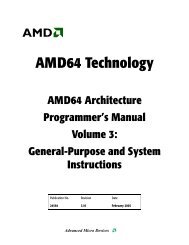Using TCP Through Sockets
Using TCP Through Sockets
Using TCP Through Sockets
You also want an ePaper? Increase the reach of your titles
YUMPU automatically turns print PDFs into web optimized ePapers that Google loves.
general, a client wishing to create a <strong>TCP</strong> connection to a server first calls socket to create<br />
a socket, optionally calls bind to specify a local address, and finally connects to the server<br />
using the connect system call.<br />
The function tcpconnect shows all the steps necessary to connect to a <strong>TCP</strong> server. It<br />
makes the following system calls:<br />
• int socket (int domain, int type, int protocol);<br />
The socket system call creates a new socket, just as open creates a new file descriptor.<br />
socket returns a non-negative file descriptor number on success, or −1 on an error.<br />
When creating a <strong>TCP</strong> socket, domain should be AF INET, signifying an IP socket, and<br />
type should be SOCK STREAM, signifying a reliable stream. Since the reliable stream<br />
protocol for IP is <strong>TCP</strong>, the first two arguments already effectively specify <strong>TCP</strong>. Thus,<br />
the third argument can be left 0, letting the Operating System assign a default protocol<br />
(which will be IPPROTO <strong>TCP</strong>).<br />
Unlike file descriptors returned by open, you can’t immediately read and write data to<br />
a socket returned by socket. You must first assign the socket a local IP address and<br />
port number, and in the case of <strong>TCP</strong> you need to connect the other end of the socket<br />
to a remote machine. The bind and connect system calls accomplish these tasks.<br />
• int bind (int s, struct sockaddr *addr, int addrlen);<br />
bind sets the local address and port number of a socket. s is the file descriptor number<br />
of a socket. For IP sockets, addr must be a structure of type sockaddr in, usually<br />
as follows (in /usr/include/netinet/in.h). addrlen must be the size of struct<br />
sockaddr in (or whichever structure one is using).<br />
struct in_addr {<br />
u_int32_t s_addr;<br />
};<br />
struct sockaddr_in {<br />
short sin_family;<br />
u_short sin_port;<br />
struct in_addr sin_addr;<br />
char sin_zero[8];<br />
};<br />
Different versions of Unix may have slightly different structures. However, all will have<br />
the fields sin family, sin port, and sin addr. All other fields should be set to zero.<br />
Thus, before using a struct sockaddr in, you must call bzero on it, as is done in<br />
tcpconnect. Once a struct sockaddr in has been zeroed, the sin family field must<br />
be set to the valueAF INET to indicate that this is indeed asockaddr in. (Bind cannot<br />
take this for granted, as its argument is a more generic struct sockaddr *.)<br />
5
















